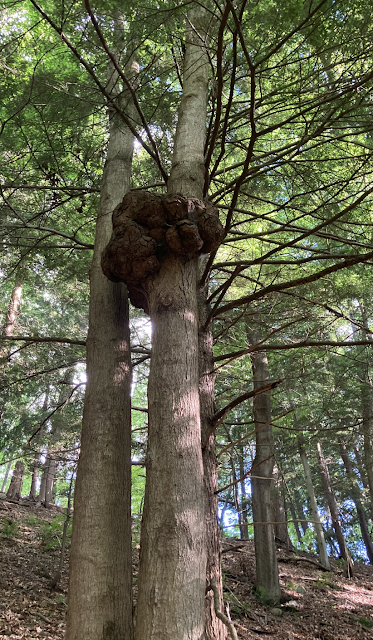A Forest Sounds Like a Ship at Sea:
Hidden Gemels
Day 24: Remote Residency at Uillinn: West Cork Arts Centre, Skibbereen, Ireland, 7/18/22 to 8/13/22, Maria Driscoll McMahon checking in from New York State
What you make from a tree should be just as miraculous as what you cut down.
Richard Powers, author of Overstory
Since beginning my residency, I have explored but the barest minimum of trees. There are so many more species of trees to get to know - not just by name - but by their characteristics, their history, their stories. I have many books I am in the process of reading, but my residency will be concluding on Saturday; thus, my ongoing research will take place in private as is usual for me! I may continue to blog, though, perhaps on a weekly - rather than daily - basis.
For today, I'd like to share some of the more unusual trees I've come across.
While searching for the trees of Ireland in Pennsylvania and New York State, I ran into several that appeared to be "conjoined" or intertwined as if in a lover's embrace. Sometimes the trees appeared to be of the same species, but in other instances, they were clearly different. I learned the term for this is inosculation, a natural phenomenon when two trees fuse together. Sometimes arborists intentionally graft trees together. Whether it happens naturally or through human manipulation, however, these trees are known as "gemels" which translates to "twins." Inosculation happens when trees grow so close they rub against each other until the growth tissue - or "cambium" fuses together.
.png) |
| Several examples of "gemels" in Pennsylvania and NY State |
 |
| This appears to be a very sick tree, but the large "tumor" isn't caused by cancer, but infestation of insects or fungi - usually harmless. They are called "galls" or "burls." |
 |
| Hemlock Shelf Varnish Fungus |
 |
| Evil is the refusal to see one's self in others. Richard Powers, author of "Overstory" |
Gemel or Inosculation (hikeinwhistler.com)
Beech Tree Facts: Purple Leaves and Rippled Bark - Woodland Trust
What Are Burls And Are They Bad For Trees (gardeningknowhow.com)
The Overstory - Richard Powers


No comments:
Post a Comment